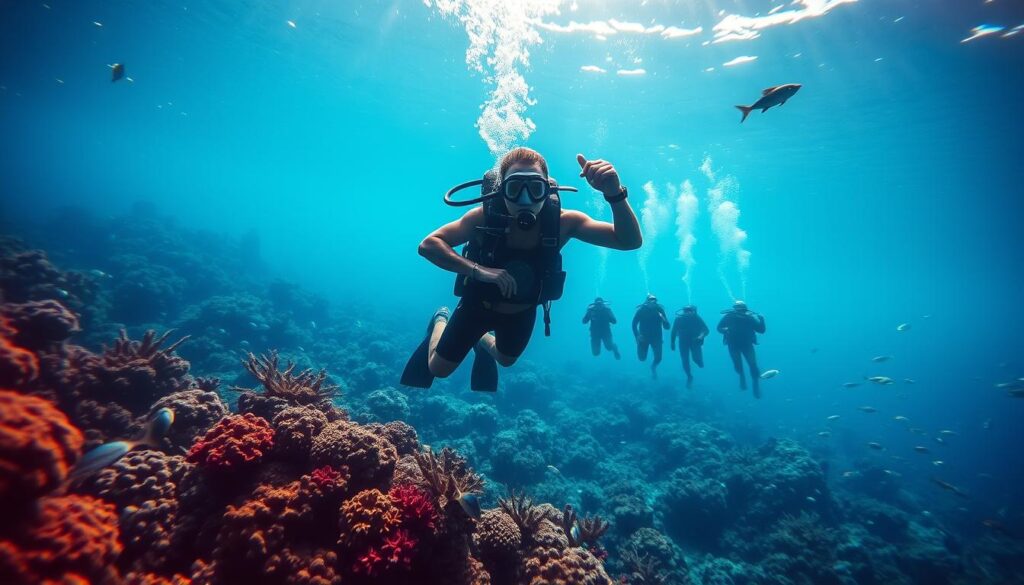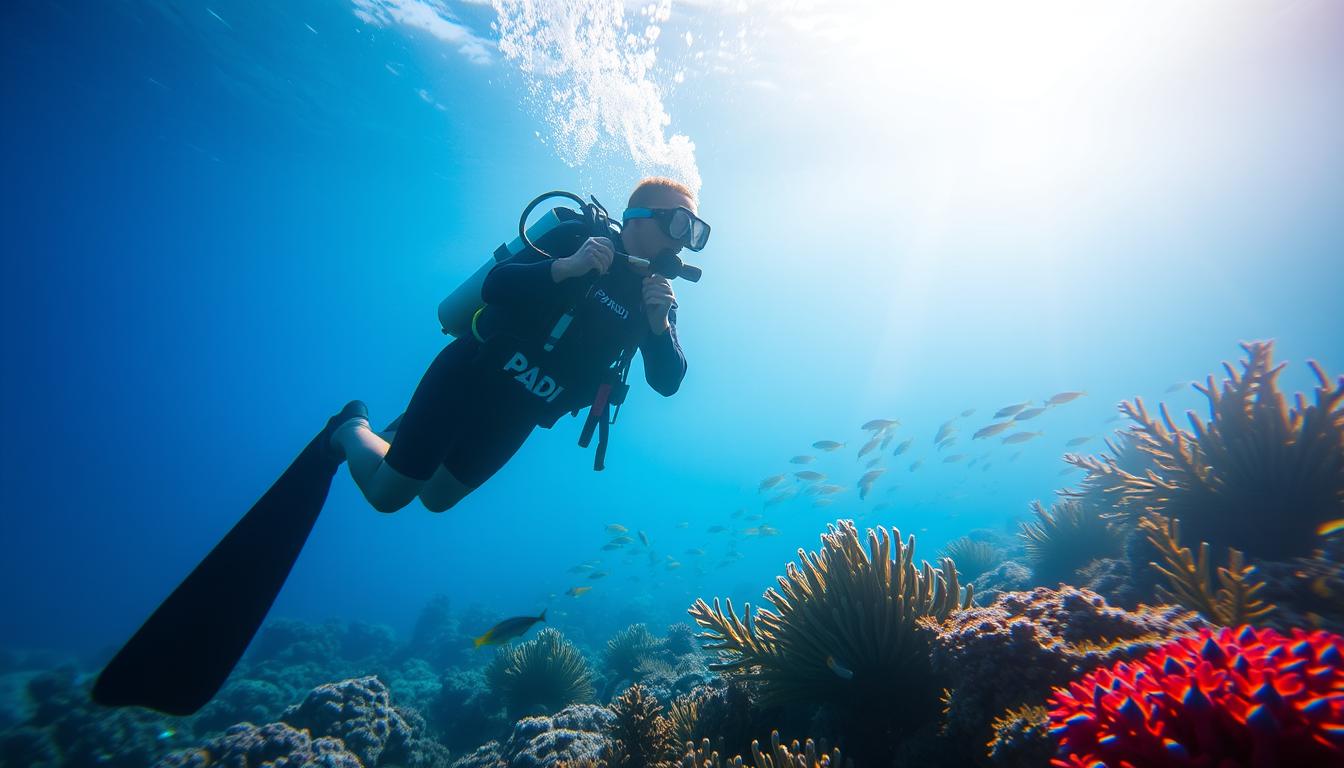PADI certification means you can see amazing things underwater. Think of swimming among colorful fish and old shipwrecks. It’s a top dive certificate because it lets you have awesome sea adventures. It also helps the oceans stay healthy. Plus, you join a worldwide group of divers who care about the sea just like you.
Key Takeaways
- PADI certification offers access to incredible marine environments.
- Learning to scuba dive through PADI is a transformative experience.
- Join a global community advocating for ocean preservation.
- Scuba diving schools provide structured and safe training.
- Getting certified promotes ocean health and conservation.
What is PADI Certification?
PADI certification is known worldwide in the scuba diving community. It shows that a diver is trained well for safe and responsible diving.
PADI Open Water Diver Course
The PADI Open Water Diver course is very popular. It’s the first step for those who want to dive. It teaches diving theory and practical skills for safety and fun.
Benefits of Getting Certified
Being certified has many cool perks. Certified divers can rent gear and explore oceans. They also help protect the sea with other divers who care about marine life.
Who Can Get Certified?
Almost anyone can get the PADI open water certification. You must be at least 10 and able to swim. You also need to be healthy. The courses make sure you’re ready for diving safely.
Steps to Become a PADI Certified Diver
Becoming a PADI certified diver has critical steps. These build your confidence and ability underwater. Each step helps you grow, from learning the basics to practical diving.
Below is what to expect in the certification process.
Phase 1: Knowledge Development
First, you start with learning crucial scuba principles. This includes how to use equipment and stay safe. This phase focuses on understanding diving rules and how scuba gear works.
Students learn important theory parts of scuba diving here. It prepares you for the next, hands-on steps.
Phase 2: Confined Water Dives
Next, you practice diving in places like swimming pools. It’s safe here to learn and improve skills. Trained instructors help you. You’ll learn to set up gear and find your way underwater.
This stage is key. It moves you from just knowing to doing. It makes you feel more at ease under water.
Phase 3: Open Water Dives
The last part of your training is the open water dives. Here, you use your skills in real situations. You go on four dives in natural water spots.
These dives let you see underwater life. They also test your diving skills. It’s exciting and important for getting different diving certifications. This shows you’ve moved from beginner to certified diver.
Requirements for PADI Certification
To start your scuba diving journey, you need to know the scuba diving certification requirements. PADI has rules to make sure all divers are safe and ready.
“Diving is a life-transforming experience, but it begins with meeting the right requirements.” – PADI Instructor.
The first key thing is age. You need to be at least 10 years old for the Junior Open Water Diver course. For most other courses, you must be 12. Being healthy is also very important. You will fill out a medical form to check if you’re fit for diving.
You also need to be good at swimming. You should swim 200 meters without stopping. And you need to float or tread water for 10 minutes. These skills make sure you’re okay in the water.
Doing a medical evaluation is a big part too. You might need to see a doctor. This is to make sure there are no health issues that could be dangerous underwater. After clearing this step, you can start the course’s practical and theory lessons.
| Requirement | Details |
|---|---|
| Age | Minimum 10 years for Junior; 12 years for most courses |
| Health | Completion of health questionnaire and medical evaluation |
| Swimming Skills | 200-meter swim and 10-minute float/tread water |
These scuba diving certification requirements mean all divers are ready and safe. Knowing these rules is the first step to exploring the amazing world under the sea safely and with confidence.
PADI Certification Levels
Getting to know the different PADI certification levels is important. They help improve your diving skills. Each level teaches new things to make diving safer and more fun.
PADI Advanced Open Water Diver
The PADI Advanced Open Water Diver certification makes your diving better. You learn deep diving and how to find your way underwater. You also get to choose three fun dives, like exploring wrecks or diving at night. This opens up new underwater worlds.
PADI Rescue Diver
With the PADI Rescue Diver certification, you learn how to handle diving emergencies. It teaches you to solve problems and helps make diving safer. This certification is all about keeping divers safe and aware.
Master Scuba Diver
The Master Scuba Diver rating is a top achievement for non-professional divers. You need five special courses, the Rescue Diver course, and at least 50 dives. It shows you’re really good at diving and know a lot about it.
Specialty Courses
PADI’s specialty dive training lets you get better at certain types of diving. You can learn about deep diving, wreck diving, and night diving. Taking these special courses helps you become an expert in what you like most.
| Certification Level | Main Focus |
|---|---|
| PADI Advanced Open Water Diver | Deep diving, honing diving skills |
| PADI Rescue Diver | Emergency response, problem recognition |
| Master Scuba Diver | High skill level, diverse specializations |
| Specialty Courses | Specialized skills in areas like wreck and night diving |
Cost of PADI Certification
It’s important to know how much PADI certification costs if you want to dive. There are two big parts to the cost. These are the course fees and the money spent on gear. Both are needed to get you ready for going under the sea.
Course Fees
Course fees include signing up and paying for learning materials. Prices change based on where you are and how big your class is. For instance, the PADI Open Water Diver course usually costs between $300 and $600. Whether you learn in a group or one-on-one can also change the price. Plus, some fancy places might ask for more money for the same classes you can find elsewhere.
Equipment Costs
Equipment is the second big cost of getting certified by PADI. You need to think about buying or renting your diving gear. Important things you need are masks, fins, snorkels, wetsuits, and BCDs. Depending on what brand and quality you pick, gear can cost from $200 to $2,000.
People wanting to dive should also think about their own gear and how much it costs. Good gear makes diving more fun because you’re comfy and do better underwater.
| Cost Component | Price Range |
|---|---|
| PADI Open Water Diver Course | $300 – $600 |
| Full Set of Equipment | $200 – $2,000 |
Benefits of Being PADI Certified
Getting a PADI certification has lots of plus points. It makes diving better, lets you learn more, and go to special places. We’ll look at these good points closely.
Global Recognition
PADI certification is known all over the world. Wherever you dive, people trust your PADI skills. This means you can go on dive trips anywhere, like Australia’s Great Barrier Reef or Mexico’s cenotes.
Access to Exclusive Dive Sites
Being PADI certified lets you dive in special places. Some spots need divers to show they are skilled. This means you can see amazing underwater places that not everyone can go to. It keeps these places safe and beautiful.

Continued Education Opportunities
PADI gives you chances to keep learning new dive skills. They have many advanced courses. You could learn about taking photos underwater, diving deep, or even teaching diving. This way, diving gets more fun and interesting every time.
Choosing a PADI Dive Center
Picking the right PADI dive center matters a lot for a good dive. You need to think about several things to make a smart choice.
Factors to Consider
Choosing a dive center means looking at their certs, gear, and teacher experience. Pick centers that meet PADI’s high standards for safety and learning. Good gear and places make diving better.
Questions to Ask
Asking good questions helps pick a great dive center. Ask about course time, costs, and teacher skills. Making sure teachers know their stuff means better learning for you. Also, ask how they keep dives safe.
Finding Local Dive Shops
Find nearby PADI centers with directories or tips from friends. The official PADI website is great for finding local shops that follow PADI rules. Friends who dive can also tell you about good spots.
Advanced PADI Courses
PADI has many advanced courses to make you a better diver. You can learn more about technical diving or become a dive professional. Each course is designed for what you need.
Technical Diving Options
If you want to take on bigger challenges, PADI has technical diving courses. You’ll learn to dive deeper and handle complex situations. You’ll also learn about special gear.
Start with the PADI Advanced Open Water Diver course to build your skills. You need to do five dives. This includes two required dives and three Adventure Dives you pick. After, you can dive up to 30 meters (100 feet) and choose from many Adventure Dives.
Professional Diving Certifications
PADI has professional diving courses for careers in teaching, research, and saving the ocean. These courses prepare you for top diving jobs. You’ll be ready for advanced roles in the dive world.
The PADI Divemaster and Instructor Development Course (IDC) are great for starting a dive career. They lead to jobs like leading dives or teaching others. You can also work on ocean projects around the world.
PADI Certification Explained: What You Need to Know
PADI certification is your ticket to the underwater world. It’s not just about fun dives. It also opens doors to many benefits and chances. Whether just starting or aiming to be a pro, knowing about PADI certification is key.
The PADI certification process teaches you everything needed in clear steps. First comes knowledge development. Here, you learn key diving principles and about the gear. Next, you practice in confined water to get skills right in a safe place.
Then, you’re ready for open water dives in the real world. This makes sure you’re a safe and happy diver.
There are many PADI certification levels like Advanced Open Water Diver and Rescue Diver. Each level teaches new things to make your diving better. You can also pick from many special courses to learn more.
To sum up, PADI certification is more than diving adventure. It also teaches important safety skills and helps appreciate the ocean more. Knowing about it helps divers make the best choices for their sea adventures.
Conclusion
Jumping into PADI certification brings amazing chances for those ready to scuba dive. It guides you through learning and exciting dives. Each step prepares divers to safely explore underwater.
PADI certification means you’re recognized worldwide. You get to see special dive spots and learn more. It’s great for those wanting to dive deeper into their skills or go pro.
Getting your PADI means a world of sea exploration awaits. So, why wait? Dive in, start your adventure, and see the wonders beneath the waves today.
